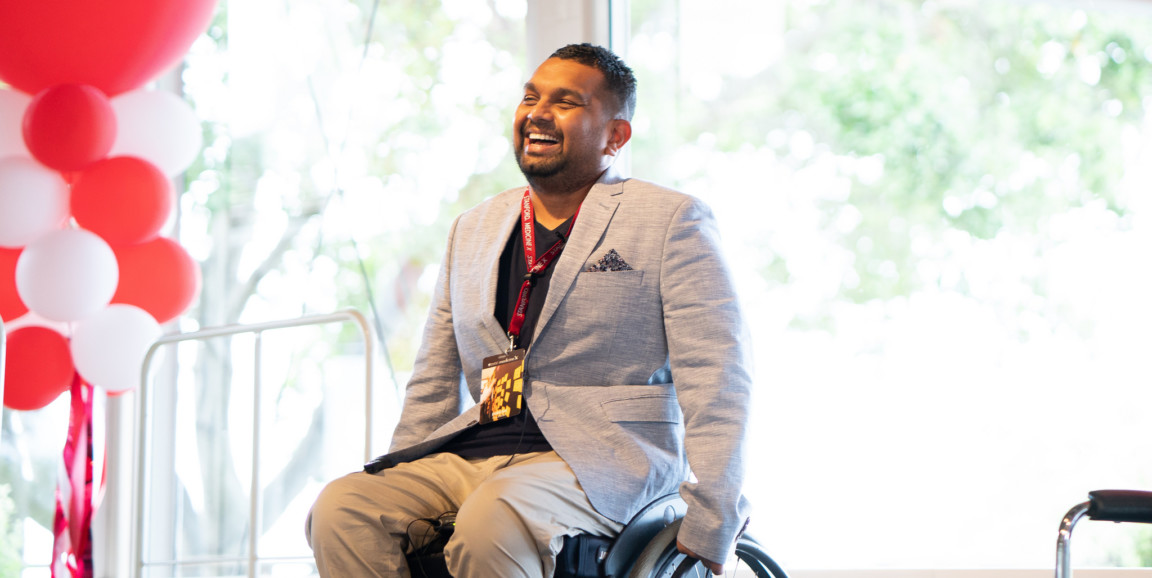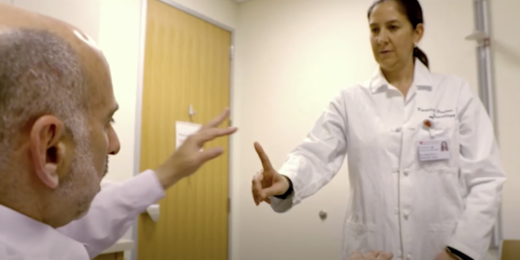When the image of the mangled car -- its front end smashed in, windows shattered -- flashed on the screen, a chill went through the Stanford Medicine X | ED audience Saturday afternoon.
"This is my car," said Dinesh Palipana, LLB, MD, looking out from the stage in his wheelchair. He had hydroplaned while driving home on a rainy night in 2010. "I tried to get out of the car, but my fingers weren't obeying my command. I couldn't feel my legs. That's when I realized what had happened. Within seconds my life had changed and I was terrified."
The crash jolted Palipana out of his life as a medical student into the role of a patient with quadriplegia. He said he hated being a patient -- but it offered him the opportunity to see firsthand the best, and the worst, ways to be a doctor.
For example: At the scene of the crash, an emergency physician he had known previously cared for him. Palipana was panicking: "I was yelling, I was in distress. I asked him what will happen to me, how will I finish medical school, how will I get on to my life?"
While providing care for his injuries, the doctor reassured Palipana: "He said that I'm in good hands. They are taking me to the best hospital; there are ways to get back to medical school; things are going to get better. Saying that made all the difference."
Soon after, Palipana witnessed some of the worst medicine had to offer. At the hospital, he needed surgery and asked his anesthesiologist what was happening. The man responded curtly: "I don't know. You're pretty badly hurt. I don't know if you are going to wake up from this." That was the last Palipana heard before falling asleep.
"Through the seven months [in the hospital], I got to experience all the different ways a patient can feel and be treated," he said. "I'm terrified to be a patient in a hospital... it's ironic because I love being a doctor in a hospital, just not a patient."
But his path to becoming that doctor was far from easy. The first step was to return to medical school. But how?
"It was such an unknown thing. I was terrified about what it would be like. I didn't know how I was going to do the things I used to do," Palipana said. "I didn't know if I could pass my exams. I was so scared in so many different ways."
His friends were supportive, but didn't provide universal encouragement. Some thought it would be safer to return to law, a field he had studied initially, but hadn't enjoyed. Palipana persevered:
I took the risk and said 'yes' and that's all it took. Despite all the different fears I had, I said yes and jumped in and gave it a chance. That turned out to be the best decision I ever made.
Palipana worked hard, extra hard even, to show everyone, including himself, that his place in medicine was merited, he wasn't a token person with a disability. He passed his exams; he won awards.
Nonetheless, when it came time for an internship, all his friends received job offers. But not Palipana.
"In our state, Queensland, there's one health system. They thought having a quadriplegic doctor was a huge risk."
Public pressure mounted: there were newspaper articles, phone calls. The system relented and Palipana received a last-minute job offer. Which, he's proud to add, he excelled at -- even succeeding in his surgery rotation, where his efforts impressed his mentor.
"[The mentor] sat me down and said, 'I'm going to be honest with you. When I heard you were coming to surgery, I was quite pessimistic this would work out. I'm really ashamed I thought that way because today I've changed my mind on a lot of things, of how medicine should be and who should be included.'"
The key point to remember is that every single person is different, disability or no, Palipana said. "Just think of people on a case-by-case basis."
"The pivotal step is just saying yes. Say yes and if things go wrong, that's all right, you've given someone the opportunity. The key step is saying yes."
Now, Palipana is a physician in Queensland and a founding member of an Australian organization, Doctors with Disabilities, which advocates to increase opportunities and acceptance of diversity in medicine.
In conclusion, he flashed an image of the late physicist Stephen Hawking, PhD, on the screen: "What if we take a bet that someone that we give an opportunity to will turn out like him. I think that's worth taking a shot at."
Photo by Justin Lai / Stanford Medicine X | ED




